The Anticipation
I barely slept last night in anticipation of my on-ice day today. I can’t believe it’s finally here. I’ve been preparing to go to Antarctica for a little over a year now and it always seemed so far away. But last night it really hit me. It’s here. It’s happening.
My day started early, heading back to the Clothing Distribution Center (CDC) to check-in for my flight. After weighing my bags, they issued me a boarding pass.
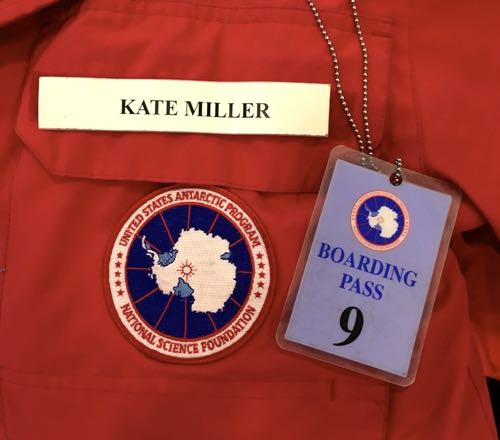 My boarding pass on top of my official United States Antarctic Program (USAP) parka.
My boarding pass on top of my official United States Antarctic Program (USAP) parka.
A few hours later and we were set to board. We were lucky not to have any delays as they’re extremely common!
LC-130
We took a bus over to an LC-130 airplane, operated by the U.S. Air Force. The Air Force helps us get to Antarctica, but there are no military operations in Antarctica (in accordance with the Antarctic Treaty).
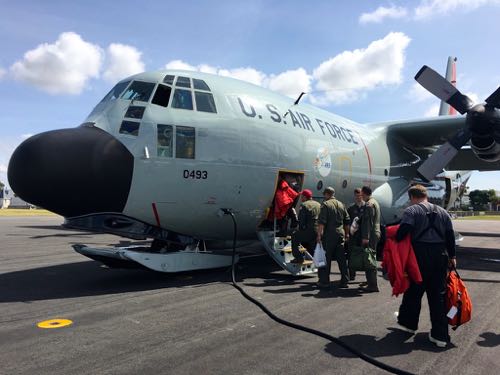 Boarding the LC-130 airplane in Christchurch, heading to McMurdo Station. Notice the skis on the bottom!
Boarding the LC-130 airplane in Christchurch, heading to McMurdo Station. Notice the skis on the bottom!
Notice that this airplane has skis in addition to wheels. The skis themselves are retractable, so wheels can be used on the take off in Christchurch and skis can be used for the landing in Antarctica.
This airplane is probably unlike anything you’ve ever ridden on before. The cargo is loaded into the back and the passengers in the front. The chairs were pull down canvas nets and our bags were strapped down in the middle. There was one toilet with a curtain around it, just a few windows, and a bag lunch waiting for us on the seat. Once the engines fired up, we all put in our earplugs – these planes are loud!
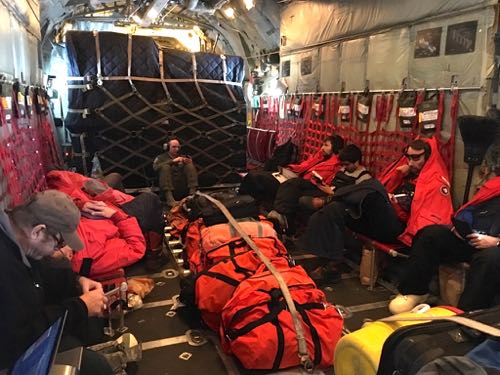 Inside the LC-130, we all sat in pull down canvas nets and our bags were strapped down in the middle. You can see the "loadmaster" sitting in the back - he's in charge of keeping the back portion of the plane in good working condition.
Inside the LC-130, we all sat in pull down canvas nets and our bags were strapped down in the middle. You can see the "loadmaster" sitting in the back - he's in charge of keeping the back portion of the plane in good working condition.
Eight Hours Later
After 8 hours of sleeping, eating, reading, sleeping and some more eating, I started to see ice out the window. We were getting close.
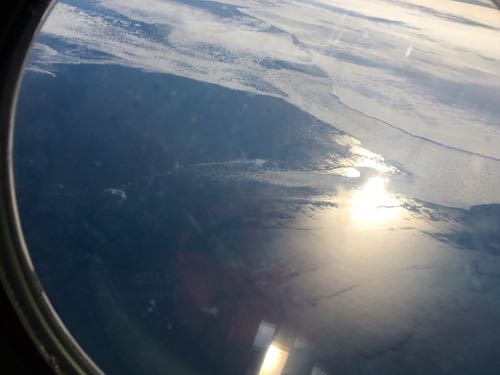 My first view of the Antarctic ice, from the window of the LC-130.
My first view of the Antarctic ice, from the window of the LC-130.
Again, we were super lucky that we did not “boomerang” back to Christchurch. Since there is no radar at the airfields at McMurdo, pilots have to rely on their sight to land safely. If your plane gets close to the airfield and the visibility has decreased too much, you turn around and head back to Christchurch only to try again the next day.
Getting to McMurdo
There are two airfields, both sitting on the Ross Ice Shelf – Phoenix Airfield and Williams Airfield. Right now, in the middle of summer, the sea ice at Phoenix Airfield is getting a bit too thin to use safely. So instead my plane flew into Williams Airfield. “Willie” is about 45 minutes away from McMurdo Station.
We hopped on a truck (this particular type is a Delta) and strapped in for a bumpy ride. We passed New Zealand’s Scott Base and drove around Mount Erebus (the southern-most active volcano on earth!) and finally arrived at McMurdo Station.
 Our ride from William's airfield to McMurdo station.
Our ride from William's airfield to McMurdo station.
McMurdo Station
McMurdo is the largest of the three U.S. bases (the other two being Amundsen-Scott South Pole Station & Palmer Station). It hosts approximately 1500 people in the summer, and approximately 150 people in the winter. Imagine a small college campus and it may look something like McMurdo Station.
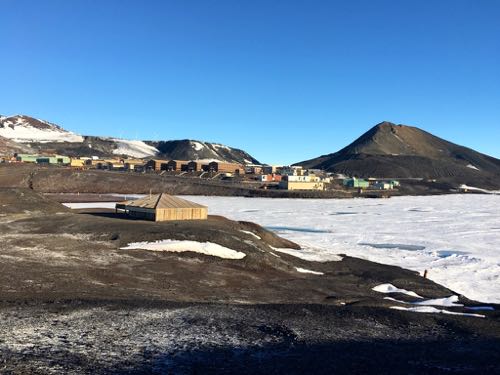 A view of McMurdo from Observation Hill.
A view of McMurdo from Observation Hill.
After a short briefing, we went to our rooms to get settled. The rooms are dorm-style, so I’m sharing with three other women.
After refueling in the cafeteria we headed over to “bag drag.” I picked up my checked bag, retagged it and dropped it back off to be taken to the South Pole. Then, a group headed to Observation Hill, an outlook point that’s about a 10-minute walk from “town.” The view is spectacular.
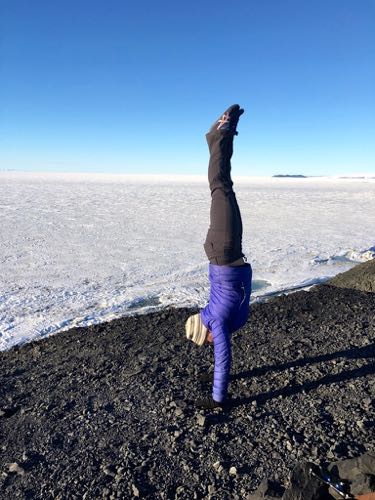 Obligatory handstand picture at the top of Observation Hill.
Obligatory handstand picture at the top of Observation Hill.
 A stunning view of the Ross Ice Shelf from the top of Observation Hill. Along the crack towards the left of the picture you can see several seals laying on the ice. This picture was taken at midnight and look how high the sun is!
A stunning view of the Ross Ice Shelf from the top of Observation Hill. Along the crack towards the left of the picture you can see several seals laying on the ice. This picture was taken at midnight and look how high the sun is!
The ice, the mountains, the seals, the sun – a perfect scene.
South Pole Tomorrow (?)
I’m scheduled to fly to the South Pole tomorrow, assuming it doesn’t get delayed. It’s still so surreal to me that I’m actually in Antarctica! It’s crazy beautiful with so many interesting people working here. I can’t wait to explore more and I hope you’ll follow along with me! Feel free to post comments and questions below – I’ll reply to them as soon as I can!


Comments
Add new comment